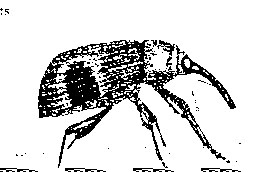Strawberry bud weevil (Clipper)
Anthonomus signatus Say
(Coleoptera: Curculionidae)

Description:
Adult is a snout beetle about 1/10 inch (3 mm) long, chestnut brown in
color, and possessing two black spots on its back (elytra). Larvae are
tiny creamy white-colored grubs found inside unopened flower buds.
Biology and damage:
The strawberry bud weevil is probably one of the most important direct
pest of strawberries in the United States. This pest has been shown to
cause yield losses from 50 to 100% in some areas (Schaefers 1981). The
strawberry bud weevil is widespead and occurs throughout virtually all
the strawberry-growing regions of this country, including Virginia
(Anderson
& Walker 1937, Davidson & Lyon 1987). Strawberry bud weevil has
one generation per year. Overwintering adults emerge early in the
season
from ground litter commonly in wooded areas and migrate to strawberry
fields
(around late April in the Mid-Atlantic region). Ovipositing females
puncture
unopened buds with their long beaks and deposit a single egg into the
bud.
Damage results when females sever the strawberry bud from the pedicel
following
oviposition, causing it to hang by part of the stem, or fall to the
ground
(Annonymus 1972), thus, preventing fruit formation. Larvae develop in
the
severed buds and reach maturity in 3-4 weeks. Adults emerge in June,
feed
on flower pollen, then enter an estavation in mid-summer and remain
inactive
the rest of the season.
Field scouting/monitoring:
One method of field scouting involves sampling weevils on plants,
during
the early blossom/bud stage. Shaefers (1981) suggests an economic
injury
level of 1 female beetle per 40 row feet. Cooley & Schloemann
(1990)
developed a sampling program using bud damage as a sampling index.
According
to this program, sample units of 2 row feet of plants are sampled at 5
to 10 locations along a v-shaped transect. Treatment is advised if an
average
of 0.6 clipped buds per row foot are found.
Management:
Recent research in New
York indicates that only rows near block edges near woods may need
to be sprayed. If compensatory varieties such as Seneca are used,
sprays
may not be needed at all.
CHEMICAL CONTROL
Virginia
home
spray
guidelines
California
guidelines
CULTURAL CONTROL:
Pistillate varieties of strawberries are relatively immune from
attack
since only varieties with staminate flowers seem to provide adequate
food
for developing larvae (Davidson & Lyon 1987). Early-fruiting
varieties
are more susceptible to attack than later-fruiting varieties. Schaefers
(1981) recommends topping of plants and removal of foliage and mulch
immediately
following harvest, then applying a follow up chemical spray to kill
overwintering
adults. Other cultural practices include avoiding field site selection
near wooded areas to prevent high numbers of overwintering adults from
entering the field in the spring. Mulches and full canopy beds
encourage
adults to overwinter and remain in the field, thus plowing of old beds
immediately following harvest causes adult mortality. Cropping fields
less
than three years is also recommended.
See also:
- Bostanian, N. J., M. Binns, J. Kovach, G. Racette and G
Mailloux.
1999.
A predictive model for strawberry bud weevil adults in strawberry
fields.
Environ. Entomol 28: 388-406.
- English-Loeb, G., M. P. Pritts, J. Kovach, R. Rieckenberg and M.
J.
Kelly.
1999. Compensatory ability of strawberries for bud and flower removal:
Implications for managing the strawberry bud weevil. J. Econ. Entomol.
92: 915-921.
- Kovach, J., R. Rieckenberg, G. English-Loeb, M. Pritts. 1999.
Oviposition
patterns of the strawberry bud weevil (Coleoptera: Curculionidae) at
two
spatial scales and implications for management J. Econ. Entomol. 92:
1358-1363.
